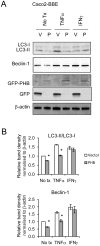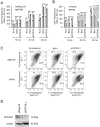Prohibitin 1 modulates mitochondrial stress-related autophagy in human colonic epithelial cells
- PMID: 22363587
- PMCID: PMC3281932
- DOI: 10.1371/journal.pone.0031231
Prohibitin 1 modulates mitochondrial stress-related autophagy in human colonic epithelial cells
Abstract
Introduction: Autophagy is an adaptive response to extracellular and intracellular stress by which cytoplasmic components and organelles, including damaged mitochondria, are degraded to promote cell survival and restore cell homeostasis. Certain genes involved in autophagy confer susceptibility to Crohn's disease. Reactive oxygen species and pro-inflammatory cytokines such as tumor necrosis factor α (TNFα), both of which are increased during active inflammatory bowel disease, promote cellular injury and autophagy via mitochondrial damage. Prohibitin (PHB), which plays a role in maintaining normal mitochondrial respiratory function, is decreased during active inflammatory bowel disease. Restoration of colonic epithelial PHB expression protects mice from experimental colitis and combats oxidative stress. In this study, we investigated the potential role of PHB in modulating mitochondrial stress-related autophagy in intestinal epithelial cells.
Methods: We measured autophagy activation in response to knockdown of PHB expression by RNA interference in Caco2-BBE and HCT116 WT and p53 null cells. The effect of exogenous PHB expression on TNFα- and IFNγ-induced autophagy was assessed. Autophagy was inhibited using Bafilomycin A(1) or siATG16L1 during PHB knockdown and the affect on intracellular oxidative stress, mitochondrial membrane potential, and cell viability were determined. The requirement of intracellular ROS in siPHB-induced autophagy was assessed using the ROS scavenger N-acetyl-L-cysteine.
Results: TNFα and IFNγ-induced autophagy inversely correlated with PHB protein expression. Exogenous PHB expression reduced basal autophagy and TNFα-induced autophagy. Gene silencing of PHB in epithelial cells induces mitochondrial autophagy via increased intracellular ROS. Inhibition of autophagy during PHB knockdown exacerbates mitochondrial depolarization and reduces cell viability.
Conclusions: Decreased PHB levels coupled with dysfunctional autophagy renders intestinal epithelial cells susceptible to mitochondrial damage and cytotoxicity. Repletion of PHB may represent a therapeutic approach to combat oxidant and cytokine-induced mitochondrial damage in diseases such as inflammatory bowel disease.
Conflict of interest statement
Figures







Similar articles
-
Nrf2 is not required for epithelial prohibitin-dependent attenuation of experimental colitis.Am J Physiol Gastrointest Liver Physiol. 2013 May 15;304(10):G885-96. doi: 10.1152/ajpgi.00327.2012. Epub 2013 Mar 14. Am J Physiol Gastrointest Liver Physiol. 2013. PMID: 23494124 Free PMC article.
-
Prohibitin 1 modulates mitochondrial function of Stat3.Cell Signal. 2014 Oct;26(10):2086-95. doi: 10.1016/j.cellsig.2014.06.006. Epub 2014 Jun 26. Cell Signal. 2014. PMID: 24975845 Free PMC article.
-
Prohibitin protects proximal tubule epithelial cells against oxidative injury through mitochondrial pathways.Free Radic Res. 2015;49(11):1393-403. doi: 10.3109/10715762.2015.1075654. Epub 2015 Sep 2. Free Radic Res. 2015. PMID: 26198983
-
Development, validation and implementation of an in vitro model for the study of metabolic and immune function in normal and inflamed human colonic epithelium.Dan Med J. 2015 Jan;62(1):B4973. Dan Med J. 2015. PMID: 25557335 Review.
-
Prohibitin( PHB) roles in granulosa cell physiology.Cell Tissue Res. 2016 Jan;363(1):19-29. doi: 10.1007/s00441-015-2302-9. Cell Tissue Res. 2016. PMID: 26496733 Free PMC article. Review.
Cited by
-
Akt phosphorylates Prohibitin 1 to mediate its mitochondrial localization and promote proliferation of bladder cancer cells.Cell Death Dis. 2015 Feb 26;6(2):e1660. doi: 10.1038/cddis.2015.40. Cell Death Dis. 2015. PMID: 25719244 Free PMC article.
-
Reactive oxygen species involved cancer cellular specific 5-aminolevulinic acid uptake in gastric epithelial cells.J Clin Biochem Nutr. 2014 Mar;54(2):81-5. doi: 10.3164/jcbn.13-98. Epub 2014 Mar 1. J Clin Biochem Nutr. 2014. PMID: 24688215 Free PMC article.
-
Flavaglines Ameliorate Experimental Colitis and Protect Against Intestinal Epithelial Cell Apoptosis and Mitochondrial Dysfunction.Inflamm Bowel Dis. 2016 Jan;22(1):55-67. doi: 10.1097/MIB.0000000000000592. Inflamm Bowel Dis. 2016. PMID: 26398710 Free PMC article.
-
Oxidative stress-induced mitochondrial dysfunction in a normal colon epithelial cell line.World J Gastroenterol. 2017 May 21;23(19):3427-3439. doi: 10.3748/wjg.v23.i19.3427. World J Gastroenterol. 2017. PMID: 28596679 Free PMC article.
-
Activating Nrf-2 signaling depresses unilateral ureteral obstruction-evoked mitochondrial stress-related autophagy, apoptosis and pyroptosis in kidney.PLoS One. 2012;7(10):e47299. doi: 10.1371/journal.pone.0047299. Epub 2012 Oct 10. PLoS One. 2012. PMID: 23071780 Free PMC article.
References
-
- Beau I, Mehrpour M, Codogno P. Autophagosomes and human diseases. Int J Biochem Cell Biol. 2011;43:460–464. - PubMed
Publication types
MeSH terms
Substances
Grants and funding
LinkOut - more resources
Full Text Sources
Research Materials
Miscellaneous

